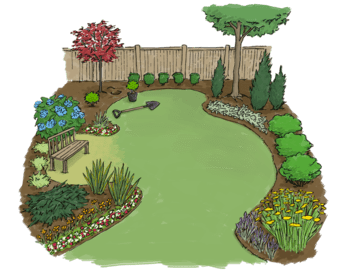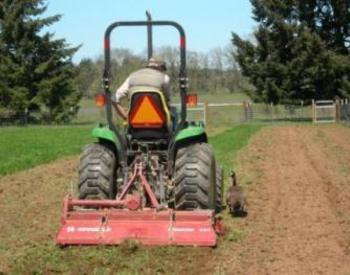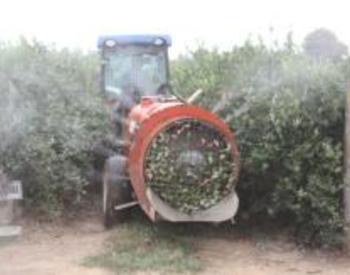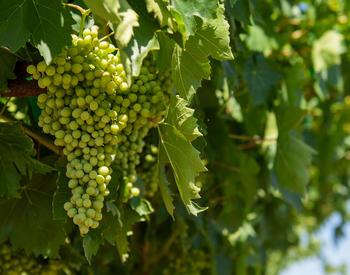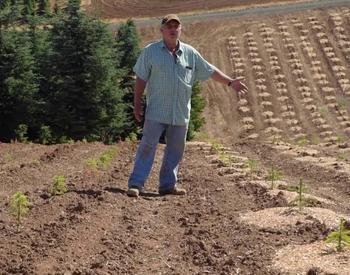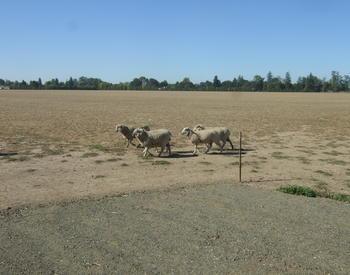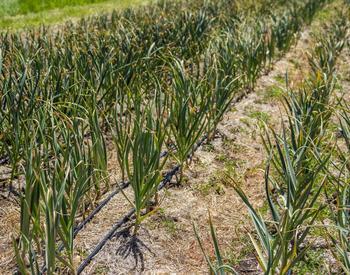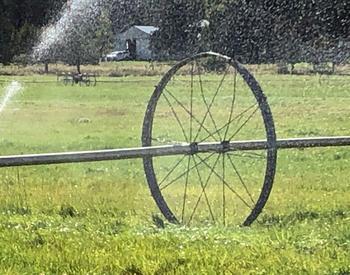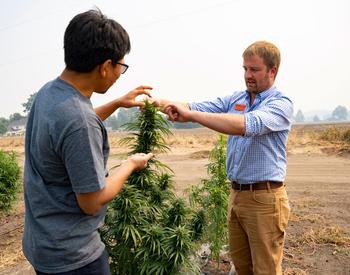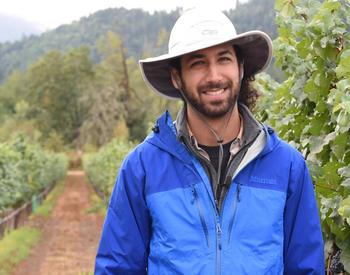Transcript
Hello, I'm Dr. Alexander Levin, viticulturist on faculty
with the Department of Horticulture
and core faculty member of the Oregon Wine Research Institute
at Oregon State University.
Today we're here in Southern Oregon
to demonstrate how to use the pressure
chamber to schedule irrigations in wine grape vineyards.
Why use a pressure chamber
The two most important questions you
need to answer for irrigation scheduling are how much
and when.
The pressure chamber is an important tool
that can be used to determine when you should irrigate.
Precisely controlling the application of water
and managing plant stress in wine grape vineyards
is critical for optimizing fruit yield and quality.
Depending on your production goals,
you may want to manage irrigation
so that your vines are not stressed for water at all
during the growing season, or you
may want to moderate water stress at key times
to manage vine vigor and/or improve fruit quality.
Either way, it's hard to manage plant stress
if you don't measure it.
Many growers use soil-based sensors
to monitor soil moisture conditions and schedule
irrigation events.
However, due to the variables of distribution
of water in the soil profile and uneven soil drying,
soil-based measurements may not be
representative of the overall condition of the vines.
By using the pressure chamber, you directly
measure the level of water stress
your vines are experiencing because it measures
the plant and not the soil.
Think of it as measuring the plant's blood pressure.
Before we dive into the instrument and the measurement
technique, let's first review what it is we
are actually measuring.
Water moves through plants from the soil
to the atmosphere along what is called a Soil-Plant Atmosphere
Continuum, or SPAC.
Water is transported in the vine through a network
of tiny pipes called the xylem.
These pipes extend uninterrupted from the root tips
all the way along a chute to the leaves.
Water is carried through the xylem
from the soil to the atmosphere, much like a straw in a drink.
In this way, the plant is connected
to both above and below-ground environments
and dynamically responds to both.
Because plants are the perfect integrators
of soil and atmosphere, plant-based measurements
are generally the most effective compared
to soil-based measurements.
When the sun rises, the light stimulates
the opening of tiny pores on the leaves, called stomates.
Water vapor is lost through these pores.
That water must be replaced.
So water is drawn into the leaf from xylem
in the petiole, which draws water
from the stem, which draws water from the trunk
and then from the root, which draws water from the soil.
There is resistance to water flow at each step of the way.
This chain of resistance creates tension in the xylem from root
to leaf.
The flow of water through the vine,
and the resulting tension in the xylem,
increase until the daily maximum is reached at midday,
between noon and 2:00 PM.
The tension in the xylem increases
because it becomes more difficult for the plant
to extract water from the drying soil as the day progresses.
After 2:00 PM or so, the flow of water through the vine
begins to decrease along with the tension in the xylem.
We can measure the tension in the xylem of the leaf
by using the pressure chamber.
And this tells us something about how much
water stress the plant feels.
This is done by enclosing a single leaf
inside a plastic sandwich bag, excising the leaf from the vine
by cutting the petiole with a sharp razor blade,
and putting the bagged leaf in a sealed chamber
with the cut petiole end remaining
outside of the chamber.
It's important to leave enough petiole tissue attached
to the leaf blade to allow it to fit into the chamber
and still protrude through the sealed grommet.
Then we slowly apply external pressure
to the leaf in the chamber and watch for sap
to rise up to the cut end of the petiole.
The amount of pressure needed to make the sap just
appear at the cut surface is related to the amount of water
tension that leaf was under.
The higher the pressure, the greater
the original tension, and the greater
the water stress of the plant.
The most commonly used units of pressure
are bars and megapascals.
The pressure we apply to the leaf and read on the gauge
is a positive number because we must
balance the tension in the xylem, which
is a negative number.
So the number that describes the tension
is the negative value of whatever we see on the gauge.
For example, if we measure 10 bars of balancing pressure,
then the tension is minus 10 bars, or minus 1.0 megapascals.
We can think of the negative number as a water deficit.
The lower the negative number, the greater
the water deficit and the greater the stress.
For example, a value of minus 12 bars, or minus 1.2 megapascals,
would indicate a greater degree of water stress
than a value of minus 8 bars, or minus 0.8 megapascals.
The scientific name we give to this negative number
is the water potential.
There are two main factors that affect the measurement of water
potential--
first, the position of the leaf on the plant, and second,
the environmental conditions that affect the whole plant.
Outer canopy leaves exposed to full sun
are losing water much more rapidly
than leaves that are in the shade.
So the water potential of the outer canopy leaves
is reduced compared to the inner canopy leaves.
Weather, soil dryness, and root health
also affect water potential values.
Weather conditions are the primary factor.
For example, cool, humid weather and wet soil
will give you a higher, less negative water potential
value, such as minus 6 or minus 7 bars.
As the soil dries and the plant has more difficulty extracting
water, you'll see a strong effect
on the water potential reading.
As tension in the xylem increases,
you'll read a lower water potential value,
such as minus 10 or minus 11 bars.
In fact, any condition that negatively
affects root health, such as disease, physical damage,
poor aeration, or compaction may negatively impact water uptake
and gives you lower water potential values.
Outro
Thanks for watching Part 1.
Now, to see the pressure chamber in use,
please join us for Part 2 of Scheduling Irrigation
with a Pressure Chamber.
How to use a pressure chamber as a tool to help you schedule irrigation in wine grape vineyards. The two most important questions you need to answer for irrigation scheduling are “How much?” and “When?” The pressure chamber is an important tool that can be used to determine when you should irrigate. Part 1 of 2 Oregon Wine Research Institute
Catalog - PNW 712


